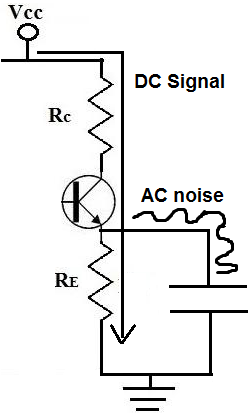What are Capacitors Used For?

Capacitors, either standalone or used with other electronic components such as resistors and inductors, have a wide variety of uses in circuits.
What capacitors are used for are shown below:
1) RC Timing Circuit
A capacitor, when combined with a resistor, is used to form a RC circuit, which acts as a timing mechanism. The combination of the value of the
resistance of the resistor and the value of the capacitance of the capacitor determines how long it takes the capacitor to charge up or to discharge in a
circuit. By using the needed values, a precise timing sequence can be made that is needed for a circuit.

The product of the RC value is called the time constant. It is this RC product, which is measured in unit seconds, which decides the timing
interval of the RC circuit.
2) AC Coupling
A capacitor is used for AC coupling. This is where a capacitor couples, or transfers, the AC portion of a signal to output and blocks the
DC from being transmitted. This is necessary in situations where the AC aspect of a signal needs to be passed as output but not the DC. In this way, the
coupling capacitor acts as a type of filter, passing AC and blocking DC.

A prime example of where coupling capacitors are needed is in microphone circuits. Microphones need DC power in order to operate, in order to turn on. However, this DC output should not appear in the output; it's only for powering the microphone. The only output we want is the user's speech, music, etc, which are AC signals. If the DC were placed in output, it could cause DC offset, which means the signal could shift up or down. To counter this, coupling capacitors remove all aspects of DC and only pass the wanted AC (music, speech, etc.)
To find out more about coupling capacitors, visit the link coupling capacitors for
more in-detail information.
3) Removes AC Noise From DC Signals
A capacitor can also be used as a bypass capacitor, which is a capacitor that shunts AC signals of a DC to ground. This cleans any AC noise that may be on DC signals, allowing
a much cleaner DC signal to be used in a circuit.

As you can see above, the capacitor in parallel to the resistor, RE serves as a bypass capacitor. This bypass capacitor bypasses the AC aspect of the signal to ground, allowing a pure DC signal to go through the resistor, RE. This helps the transistor eliminate any noise that may enter it and allows it to produce a cleaner output signal.
To find out more about bypass capacitors, visit the link, bypass capacitors for more
in-detail inofrmation.
4) Power Supply Filter
Capacitors are used to smooth the pulsating voltage from a power supply into a steady direct current (DC).

If a typical sine wave current needs to be converted into a steady DC current, the above circuit allows it to do so. A rectifier
rectifies the AC signal so that it remains above the positive threshold, producing a pulsating DC signal. A capacitor then placed in parallel to the output smoothes the signal so that
the DC output is steady in value.
5) Spike Remover
Digital logic circuits can use lots of momentary current when they switch from off to on and vice versa. This can cause very brief but
substantial reductions in power applied to nearby circuits. These power spikes (or glitches, as they are called sometimes) can be eliminated by placing
a small (0.1µF) capacitor across the power leads of the logic circuit:

A capacitor acts like a miniature battery that supplies power during the spike.
6) RC Integrator
A capacitor can also be used as an RC integrator, which is a circuit which can act as a low pass filter. A basic RC integrator is shown below:

If the input pulses are speeded up, the output waveforms (often called sawtooth) will not reach their full amplitude. Therefore, this RC integrator will reproduce signals in full which have an frequency below a certain level but not those above a certain frequency. It acts as a low-pass filter. This is good for many applications where only low-frequency signals need to be output but not higher frequency signals.
7) RC Differentiator
A capacitor can also be used as an RC differentiator. Below is a basic example of one:

An RC Differeniating circuit produces symmetrical output waves with sharp positive and negative peaks. It's used ot make narrow pulse generators for television receivers and to
trigger digital logic circuits.
Related Resources
How to Test a Capacitor
Types of Capacitors